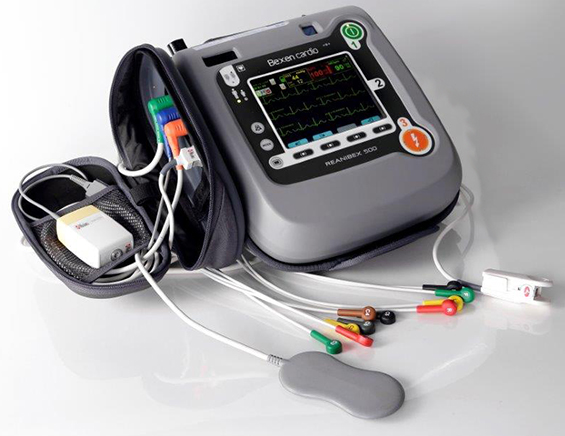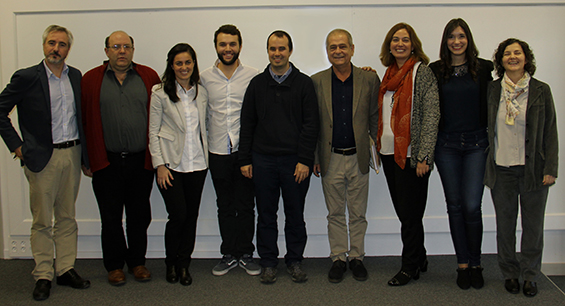
In Europe alone, around 190,000 people suffer cardiac arrests every year and most of these occur outside a hospital.The chances of surviving are slim and depend on how quickly the resuscitation process is started; this consists of immediately starting cardiopulmonary resuscitation (CPR) and having quick access to defibrillation.Fortunately, we have all observed how there is now a growing number of public places where automated external defibrillators (AED) are available to the public.As it happens, the University of the Basque Country (UPV/EHU) has been a cardiac protected area since 2012.
AEDs use automatic algorithms that record the heart rhythm and decide if it is advisable to administer an electric shock to the patient to try to correct the arrhythmia.Additionally, using visual aids and voice messages, these devices are able to instruct the person carrying out the resuscitation procedure on how they should perform chest compressions.There is an increasing tendency for these defibrillators to be automated and offer more information to the user.
Sofía Ruiz de Gauna tells us that her research group (the Signal and Communications Group at the UPV/EHU) has been working together with the company Osatu S. Coop for many years to develop increasingly “smart” systems to facilitate the resuscitation process.The defibrillators resulting from this partnership are now sold with the brand name Bexen Cardio, which supplies 5 different models of defibrillators with various features.“In 1999,” remarks Sofía, “Osatu already had extensive experience in the design and manufacture of vital sign monitors and manual defibrillators for medical use but it was looking for someone who it could work with on signal analysis, because AEDs need to analyse various signals, decide on the right treatment and make a recommendation to the person using them:to move away when the equipment is going to administer the electric shock, to start giving the patient chest compressions, etc."
This was the start of a close collaboration between the company and the university which continues today, with the development of new projects and new products.“Ever since that initial collaboration, we meet at least twice a year, regardless of whether or not we are carrying out a joint research project at the time”, Sofía tells us.“It’s very interesting to see what they are working on, what problems they are having, their concerns but, at the same time, the company also asks us about what research we are doing in the university.It is a highly beneficial relationship for both parties.”Over the years, this partnership between the company and university has resulted in new products, improvements to existing products, patents, the hiring of research staff and more besides.
One of the recent projects was carried out thanks to the 2016 Hazitek Business R&D call for grants. This call for grants is jointly funded by the Basque Government and the European Regional Development Fund (ERDF funds) and it seeks to promote competitive or strategic research.Companies or agents from the Basque Science, Technology and Innovation Network (like the Euskoiker Foundation or the UPV/EHU) can participate and their aim can be to launch new technology-based businesses or develop new products.
In this case, the aim was to add an automatic feature to the AED that would provide feedback on the quality of the chest compressions given during CPR. Together with Osatu, the UPV/EHU’s Signal and Communications Group designed and approved a CPR feedback device ("push-pad"), a type of pad that is placed on the patient’s chest to perform chest compressions.This “push-pad” has an accelerometer that makes it possible to determine whether the person giving the chest compressions is doing it properly, i.e. with the right depth and frequency (from 50-60 mm and between 100 and 120 compressions per minute).However, accurately calculating the depth of the compressions with nothing but an accelerometer presents technical problems, so it is normally necessary to add other kinds of sensors.“They asked us to develop an algorithm that allows the depth and frequency of the chest compressions to be measured using nothing but the data from the accelerometer,” explains Digna González, a researcher hired through the Euskoiker Foundation to develop the project.“After trying different approaches, we realised that we could process the signal from the accelerometer to measure the depth of the compressions with an error of less than 2 mm”.
This breakthrough in acceleration signal processing has allowed us to design a simpler product that is less cumbersome and easier to use than previously existing options.The information about the depth of the compressions is used to provide feedback to the person performing the resuscitation procedure, since the compressions have to be effective to increase the chances of survival.The new product will soon be on the market with the brand name Bexen Cardio.
 The UPV/EHU’s Signal and Communications Group: From left to right, José Julio Gutiérrez (assistant professor), Luis Alberto Leturiondo (associate professor), Izaskun Azcarate (postdoctoral researcher), Mikel Leturiondo (predoctoral fellow), Koldo Redondo (postdoctoral researcher), Jesus Mª Ruiz (full professor, founder and leader of the group), Sofía Ruiz de Gauna (assistant professor), Digna Mª González (postdoctoral researcher) and Purificación Saiz (assistant professor).
The UPV/EHU’s Signal and Communications Group: From left to right, José Julio Gutiérrez (assistant professor), Luis Alberto Leturiondo (associate professor), Izaskun Azcarate (postdoctoral researcher), Mikel Leturiondo (predoctoral fellow), Koldo Redondo (postdoctoral researcher), Jesus Mª Ruiz (full professor, founder and leader of the group), Sofía Ruiz de Gauna (assistant professor), Digna Mª González (postdoctoral researcher) and Purificación Saiz (assistant professor).
“It gives me great satisfaction to see that there are things that we research that can directly benefit society”, explains Sofía, “and this relationship also allows us to observe the daily life of a business and the problems it faces.”Additionally, Sofía also highlights the value provided by such projects during open days:“it’s fantastic to be able to tell the high school students who come to find out about Telecommunication Engineering that this equipment, which they can see before them and is on the market, was not developed by an American multinational, but through the R&D projects in which the UPV/EHU participates.”
In turn, Digna explains that “when you start a doctoral thesis you’re not really sure what the final result will be.We knew that we were going to work in the area of resuscitation and that there were certain challenges that we would have to overcome, but until we devised this algorithm, performed the tests, saw that it worked so well and decided to apply for the patent, we weren't sure that we were on the right track. Up until that point I did a lot of basic research, read a lot of literature, observed how other people fixed the same problem and tried to propose other innovative methods.This is very difficult and very often frustrating.That is why it gave me great satisfaction to see the prototype at the end of the process.This is a very tangible result of your research.”
Do you need an expert? Contact us
What is the benefit of contracting projects with companies?
¿Cómo puedo contratar proyectos con la Universidad?
Euskoiker has more than 30 years of experience managing all kinds of projects